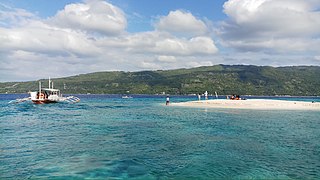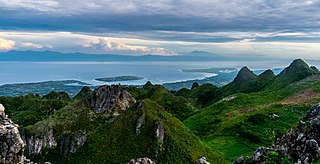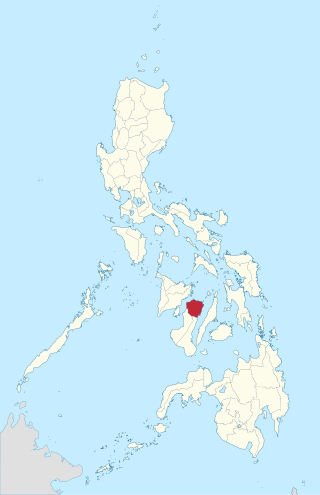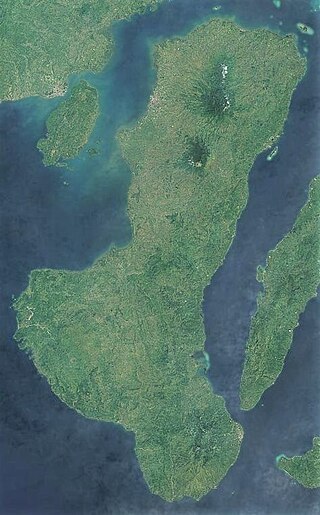Related Research Articles

Negros Occidental, officially the Province of Negros Occidental (Hiligaynon: Kapuoran sang Nakatungdang Negros (Negros Occidental; Tagalog: Lalawigan ng Kanlurang Negros, is a province in the Philippines located in the Western Visayas region. Its capital is the city of Bacolod, of which it is geographically situated and grouped under by the Philippine Statistics Authority, but remains politically independent from the provincial government. It occupies the northwestern half of the large island of Negros, and borders Negros Oriental, which comprises the southeastern half. Known as the "Sugarbowl of the Philippines", Negros Occidental produces more than half the nation's sugar output.

Oslob, officially the Municipality of Oslob, is a 4th class municipality in the province of Cebu, Philippines. According to the 2020 census, it has a population of 29,264 people.

Escalante, officially the City of Escalante, is a 4th class component city in the province of Negros Occidental, Philippines. According to the 2020 census, it has a population of 96,159 people.

Sagay, officially the City of Sagay, is a 3rd class component city in the province of Negros Occidental, Philippines. According to the 2020 census, it has a population of 148,894 people.

Toboso, officially the Municipality of Toboso, is a 3rd class municipality in the province of Negros Occidental, Philippines. According to the 2020 census, it has a population of 43,445 people.

Apo Island is a volcanic island covering 74 hectares in land area, 7 kilometers off the southeastern tip of Negros Island and 30 kilometers south of the Negros Oriental capital of Dumaguete in the Philippines. The name "Apo" means "elder" or "respected ancestor" in the Visayan languages.

The Negros Occidental Football Association is a Filipino football association based in Bacolod. It works under the Philippine Football Federation as provincial football association for the Negros Occidental area. The president of the association is Ricardo Yanson Jr since January 30, 2015. San Carlos, Negros Occidental mayor, Gerardo Valmayor Jr. is Yanson's Vice President. Yanson seceded Carlos Cojuangco as president.

The legislative districts of Negros Occidental are the representations of the province of Negros Occidental in the various national legislatures of the Philippines. The province is currently represented in the lower house of the Congress of the Philippines through its first, second, third, fourth, fifth, and sixth congressional districts.

Apo Reef is a coral reef system in the Philippines situated in the western waters of Occidental Mindoro province in the Mindoro Strait. Encompassing 34 square kilometres (13 sq mi), it is considered the world's second-largest contiguous coral reef system, and is the largest in the country. The reef and its surrounding waters are protected areas administered as the Apo Reef Natural Park (ARNP). It is one of the best known and most popular diving regions in the country, and is in the tentative list for UNESCO World Heritage Sites.

The following outline is provided as an overview of and topical guide to the Philippines:

The State University of Northern Negros (SUNN), formerly Northern Negros State College of Science and Technology, abbreviated as NONESCOST, is a state university in Sagay, Negros Occidental, Philippines.

The Tañon Strait is a body of water, separating the islands of Negros and Cebu in the Visayas, Philippines. The strait, which is about 160 kilometres (100 mi) long, connects the Visayan Sea in the north to the Bohol Sea in the south. Its width varies from 5 to 27 kilometres, with the narrowest point in the south. In the north the strait is closed off by the Don Islands, the largest of which is Bantayan. The cities of San Carlos, Negros Occidental, Bais, Negros Oriental and Toledo, Cebu have deepwater port facilities. The Tañon Strait is known for whale and dolphin watching, with tour boats operating from Bais.

Angel Chua Alcala was a Filipino biologist who was named a National Scientist of the Philippines in 2014. Alcala is known for his fieldwork to build sanctuaries and to promote biodiversity in the aquatic ecosystems of the Philippines. He was the Chairman of the Board of Advisers at the Angelo King Center for Research and Environmental Management located in Silliman University. Alcala published more than 200 peer-reviewed articles and books and his biological contributions to the environment and ecosystems have made him a renowned figure of natural sciences in the Philippines.

Negros del Norte was a province of the Philippines, located within the Western Visayas region. It existed in 1986 and was abolished later the same year. The law establishing the province was nullified by the Supreme Court of the Philippines on August 18, 1986.

Negros is the fourth largest and third most populous island in the Philippines, with a total land area of 13,309 km2 (5,139 sq mi). Negros is one of the many islands of the Visayas, in the central part of the country. The predominant inhabitants of the island region are mainly called Negrenses. As of 2020 census, the total population of Negros is 4,656,945 people.

The Northern Negros Natural Park is a protected area of the Philippines located in the northern mountainous forest region of the island of Negros in the Visayas. It is spread over five municipalities and six cities in the province of Negros Occidental and is the province's largest watershed and water source for seventeen municipalities and cities including the Bacolod metropolitan area. The park was established first as a forest reserve spanning 107,727 hectares on 28 April 1935 through Administrative Act No. 789 signed by Governor-General Frank Murphy. On 7 August 1946, the Northern Negros Forest Reserve was reduced to its present area of 80,454.5 hectares with the signing of Proclamation No. 798 by President Manuel Roxas. In 2005, the protected area was converted into a natural park under the National Integrated Protected Areas System (NIPAS) Act by virtue of Proclamation No. 895 signed by President Gloria Arroyo.

Alfredo Galicia Marañon Jr. was a Filipino politician from Sagay City who served as Governor of Negros Occidental.

The Sagay massacre occurred when a group of gunmen shot and killed nine sugarcane farmers, including four women and two children, while they were eating dinner in a makeshift tent on a farm in Sagay, Negros Occidental, on October 20, 2018. The farmers were members of the National Federation of Sugar Workers (NFSW), and the massacre may have been motivated by ongoing conflicts over land reform in the Philippines.

Negros Occidental's 2nd congressional district is one of the six congressional districts of the Philippines in the province of Negros Occidental. It has been represented in the House of Representatives of the Philippines since 1916 and earlier in the Philippine Assembly from 1907 to 1916. The district consists of the northern Negros Occidental cities of Cadiz and Sagay, as well as the adjacent municipality of Manapla. It is currently represented in the 19th Congress by Alfredo Marañon III of the National Unity Party (NUP).
References
- ↑ "Sagay City – Negros Occidental" . Retrieved April 16, 2012.
- ↑ "Sagay Marine reserve wows guvs". November 22, 2010. Retrieved April 16, 2012.
10°54′N123°25′E / 10.900°N 123.417°E